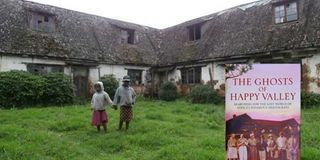‘The Ghosts of Happy Valley’: a journey into Kenya’s past

The Buxton House, the Happy Valley home of colonial aristocrat Countess Alice de Janze. Cover of Juliet Barnes' novel The Ghosts of Happy Valley. (inset) It is one of the once splendid country houses that today lies in a state of decaying dereliction. PHOTO/FILE/JOHN FOX
What you need to know:
- There were settlers who made their homes in the Wanjohi Valley who were more into having fun – with drink, drugs and sex parties – than managing farms. Many of them were of an aristocratic stock. And in those days before the prying paparazzi – always on the loo
- For ten or so years Juliet drove in her old Land Rover around the Wanjohi Valley – the valley of the Wanjohi River that flows from Mount Kipipiri to the north of the Kinangops, along the wall of the Aberdares, and up to Ol Kalou and the south of Lake Ol Bolossat.
- Together, Juliet and Solomon “re-discovered” the remains of the houses like Clouds to the south or Slains to the north, where outrageously daring women like lady Idina Sackville and Alice de Janzé orchestrated their wild partner-swapping parties.
- But, I have found even more fascinating Juliet’s descriptions of her encounters with the people who now live in those dilapidated houses, who work their small shambas, or make their livings out of selling or serving from their kiosks in the rapidly expanding townships. It’s a sensitive counterpoint to the reminiscing about the affluent lifestyles of the settlers.
“You’re not James Fox, are you?” Sir Michael Blundell barked down the phone in his loud but polished English voice when I rang him to ask for an interview about his memories of President Jomo Kenyatta.
“No, I’m John – John Fox.”
“That’s fine then,” he agreed. “Come round for tea tomorrow.”
It was later, in another conversation, when I was helping Blundell with his memoirs, that I came to understand why he so disliked James Fox’s popular White Mischief, the book, and later film, about the hedonistic goings-on of the settlers in the Happy Valley – and focusing on the murder in 1941 of one of the lead characters, Josslyn Hay, the 22nd Earl of Erroll.
Blundell came out to learn farming in Kenya in 1925, apprenticed to a soldier-settler in the Kipkarren Valley and alongside the railway line that was slowly snaking its way to Eldoret. After a few years, he had bought his own farm in the Solai Valley near Nakuru. In 1929, the Wall Street Crash occurred, and the consequence was the Great Depression of the 1930s that affected countries across the world. So for men like Blundell, and for the majority of the settlers, farming in Kenya was not only hard work, it was not at all easy to make ends meet.
INFAMOUS ARISTOCRATS
But there were settlers who made their homes in the Wanjohi Valley who were more into having fun – with drink, drugs and sex parties – than managing farms. Many of them were of an aristocratic stock. And in those days before the prying paparazzi – always on the look-out to catch Princess Kate with her bra off, or Prince Harry with his pants down – the Happy Valley set could feel free to let their hair and other things down in the high (in more ways than one) lands of colonial Kenya.
Even the British princes – Edward, the Prince of Wales, and Prince Henry – joined in on their occasional trips to Kenya. They shared the same mistress here, so it is said; certainly one of them had a child with her. But the lady was summoned to the chambers of the royal lawyers, paid an annual stipend, told to leave her child behind and never return to England. The British royals would never get away with such things these days, would they?
But why am I talking about all this? Because I have just come across a very interesting book by Juliet Barnes. It’s called The Ghosts of Happy Valley. And, as its subtitle says, it describes a search for ‘the lost world of Africa’s infamous aristocrats’.
Well, that world is not entirely lost, as Juliet Barnes found out. The cast of players has long gone; their estates were divided up and given out in the “million acre scheme” at independence; but many of their houses are still standing, though most are in a very bad state of disrepair.
MYSTERY MURDER
Juliet Barnes has lived her whole life in Kenya. She now stays in a cottage on Lord Delamere’s Soysambu estate and beside Lake Elmenteita. Her grandparents knew some of the Happy Valley set – and Juliet no doubt relished their stories. She is also intrigued by the mystery of the Earl of Erroll’s murder.
For ten or so years Juliet drove in her old Land Rover around the Wanjohi Valley – the valley of the Wanjohi River that flows from Mount Kipipiri to the north of the Kinangops, along the wall of the Aberdares, and up to Ol Kalou and the south of Lake Ol Bolossat.
She needed a guide, and she couldn’t have found a better one than Solomon Gitau, who was born and brought up in the area and who has made a creative nuisance of himself as an activist for conserving the area’s forests and, especially, the endangered colobus monkeys.
Together, Juliet and Solomon “re-discovered” the remains of the houses like Clouds to the south or Slains to the north, where outrageously daring women like lady Idina Sackville and Alice de Janzé orchestrated their wild partner-swapping parties.
But, I have found even more fascinating Juliet’s descriptions of her encounters with the people who now live in those dilapidated houses, who work their small shambas, or make their livings out of selling or serving from their kiosks in the rapidly expanding townships. It’s a sensitive counterpoint to the reminiscing about the affluent lifestyles of the settlers.
Let me give you one example:
A brindled cockerel joined me in the café, defecating under the table while giving my shoe a sideways look. Through the plastic ribbons that fluttered from the doorway, I could see sheep picking their way across the litter-strewn patch of bright-green grass. A gaggle of barefoot kids wandered past, stopping and giggling at the doorway when they saw me...
Also, if you would like a review of all the theories about who murdered the Earl of Erroll, you will find it in Juliet’s book – but I don’t myself go along with the more complex and fanciful one Juliet seems to prefer.





